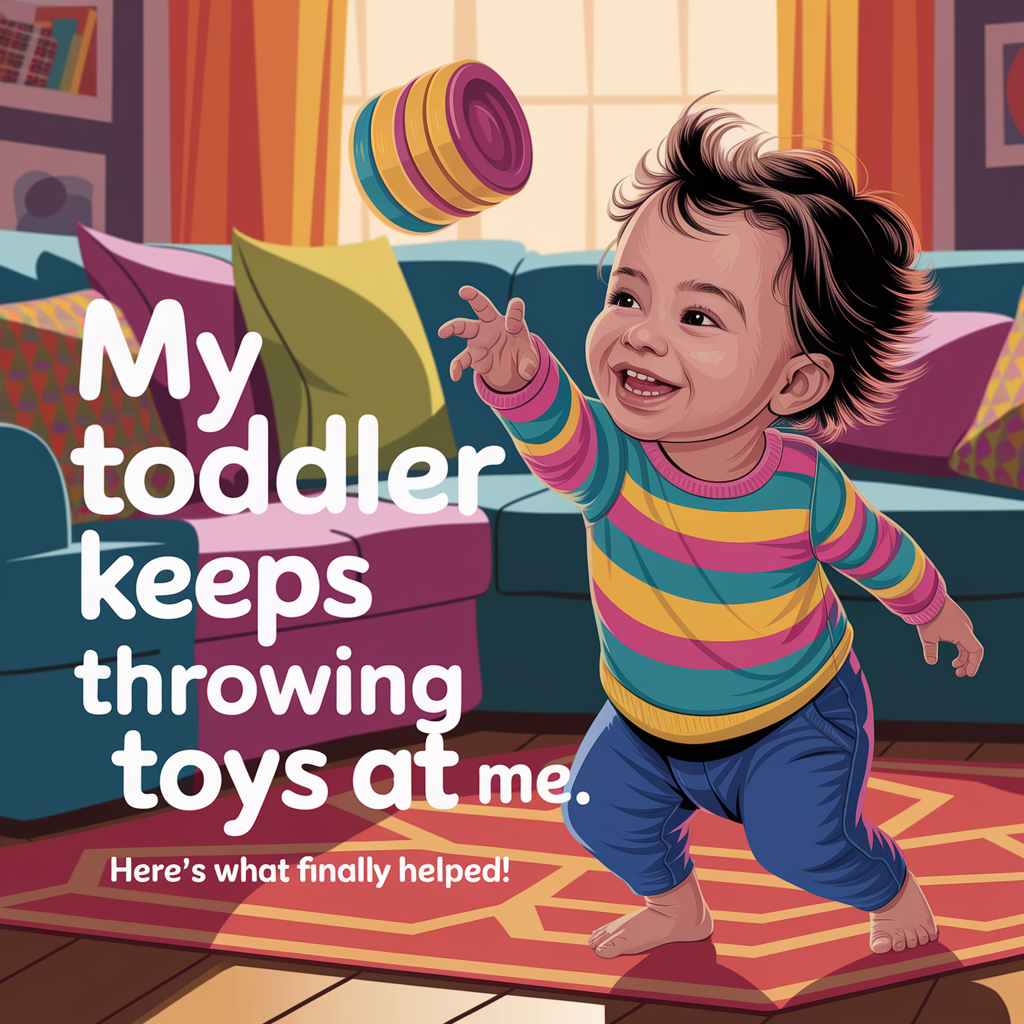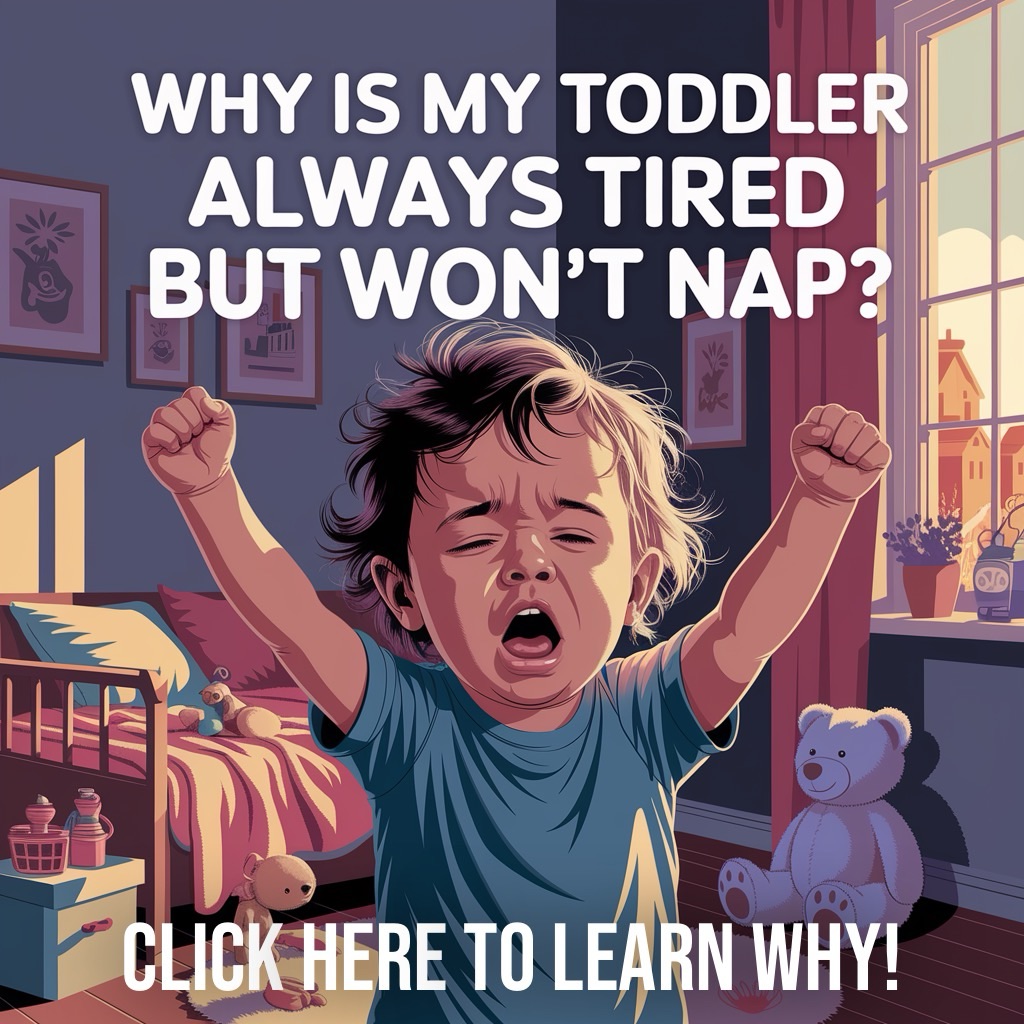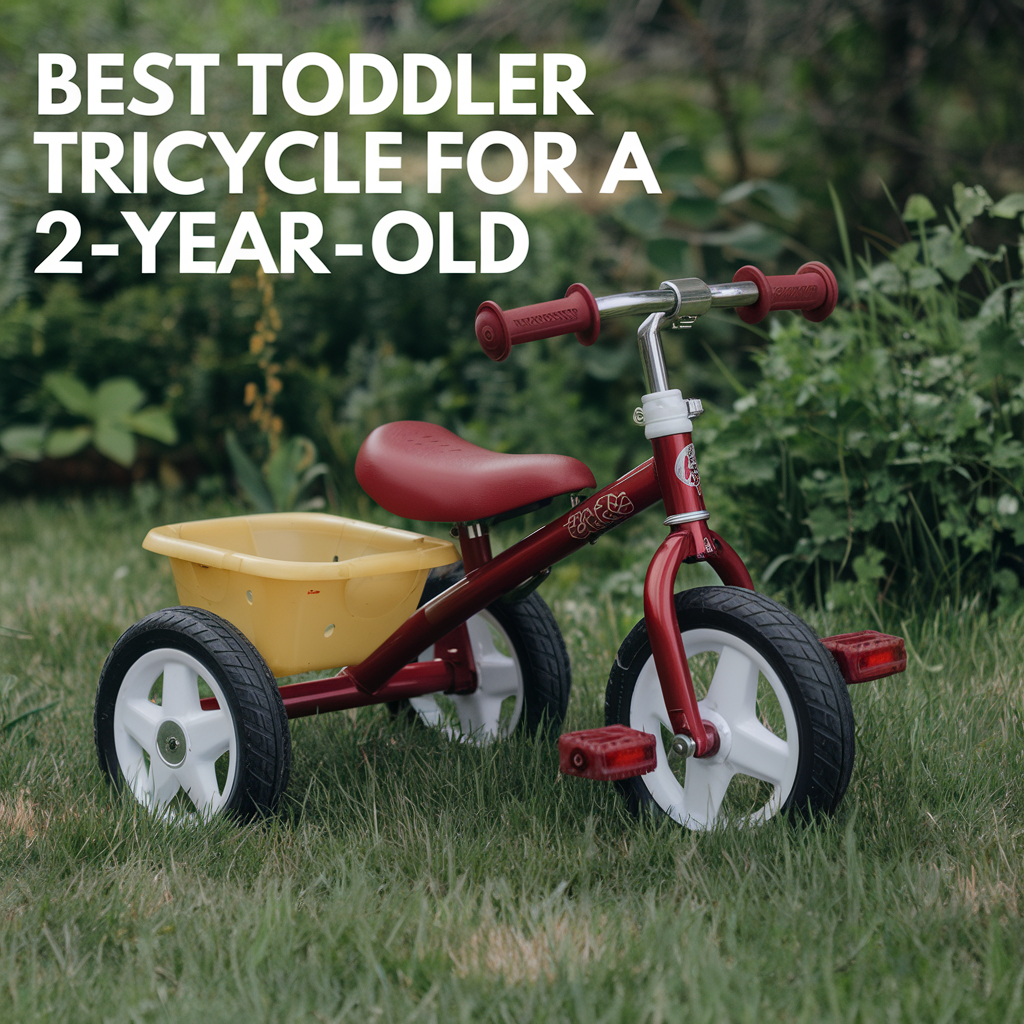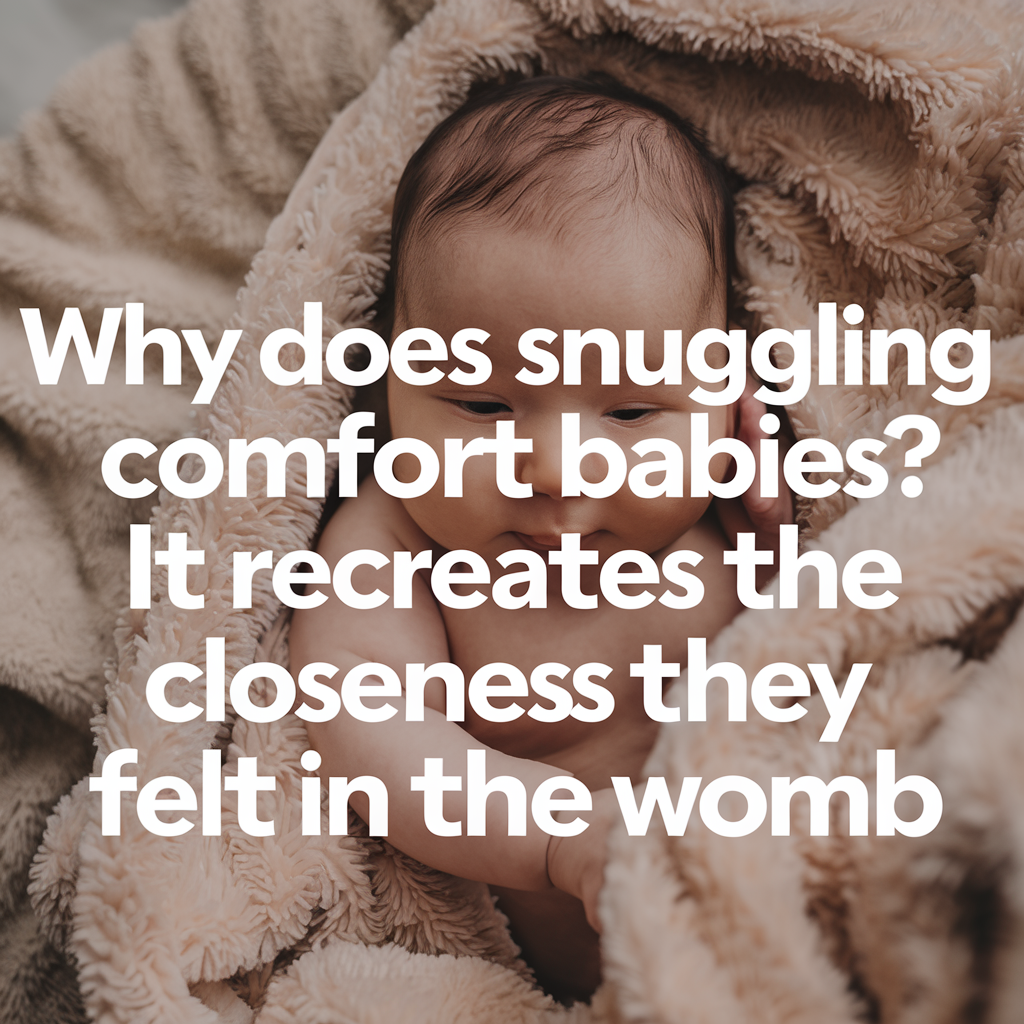
Why Does My Toddler Throw Things at Me?
I wish I could say this happened just once, but… nope. I’ve been hit with everything from soft blocks to sippy cups to a very full bowl of macaroni. It’s like my toddler turns into a tiny pitcher anytime he feels frustrated—or excited—or tired—or honestly, just because.
The first time he threw something at my face, I was stunned.
The second time, I was annoyed.
By the fifth time, I started to wonder:
“Why is my toddler throwing things at me… and how do I make it stop without turning into a yelling machine?”
Turns out, throwing is a totally normal (though wildly frustrating) phase in toddlerhood. It’s part communication, part testing limits, and part sensory exploration. And no, it doesn’t mean your toddler is mean or has anger issues.
It does mean they’re still learning how to process big feelings—and sometimes those feelings get launched across the room.
Once I understood the why behind it, I could handle it with a lot more patience and a lot less panic. (Most days. Let’s be real—I still flinch every time I hand him a banana.)

Our First Experience With the Throwing Phase
It started with toys. He’d throw a car across the room with a loud “NO!” during playtime. I chalked it up to frustration. Then came the food. And then one day, he hurled a soft book at me because I picked the wrong episode of Bluey.
That’s when I knew… we were entering the throwing era.
At first, I didn’t respond consistently. Sometimes I ignored it. Other times I got mad. Once, I even laughed out of pure shock—and guess what? That made him do it again. (Toddlers are excellent little scientists when it comes to testing reactions.)
I finally started looking into it and found that toddler throwing behavior is deeply tied to emotional expression. If your child doesn’t yet have the words—or self-control—to express how they’re feeling, they’ll use their body. And sometimes that means tossing a snack across the room.
Reading more about understanding toddler behavior helped me realize it wasn’t about me. It wasn’t defiance. It was communication… just the messy, frustrating kind.
And if you’ve ever been hit with a flying banana, you know it takes every ounce of your parenting strength not to throw one right back. But that’s where the real work begins.

What Throwing Means Emotionally for Toddlers
Once I took a breath (and wiped peanut butter off my shirt), I realized that my toddler wasn’t throwing stuff to be “bad”—he was overwhelmed. That one small action—chucking a toy, a cup, or whatever he could grab—was his way of shouting: “I don’t know how to say what I’m feeling right now!”
It’s not just about anger
Sure, sometimes throwing is fueled by frustration. But other times, it’s actually about excitement, overstimulation, or even boredom. I started noticing patterns—he’d throw things when he was overtired, overstimulated, or not getting the reaction he wanted. Just like the daily meltdown we dealt with after school, it was his brain crying out for help.
It’s a sensory release
Throwing offers quick, intense feedback: noise, motion, and adult reaction. For toddlers who are still learning how to manage all that sensory input, it’s irresistible. Especially if you have a sensory-seeking kiddo, throwing might be their way of grounding themselves.
They’re testing boundaries
Toddlers are scientists. They’re always testing “What happens if…” Throwing is no exception. “What happens if I throw my cup?” “What if I throw it at Mom?” Even a negative reaction teaches them something—which is why consistency matters so much.
I started thinking of throwing as one of those weird toddler behaviors that’s annoying for us, but educational for them.Just like how interrupting constantly is often their way of asking for connection, throwing was my toddler’s version of, “Do you see me? Do I have control?”
And once I could see it that way, I could actually start responding in ways that helped—not just reacted.

Is This Normal Behavior or a Red Flag?
Let’s be honest—it feels personal when your toddler throws something directly at your head. But here’s the truth that helped me exhale: most toddler throwing is totally normal. It’s part of how they explore, communicate, and (unfortunately for us) test boundaries.
Still, there were moments I caught myself wondering, “Is this more than just a phase?” So I did a little digging—and checked in with our pediatrician—just to be safe.
Signs it’s likely just a typical toddler phase
- Your child throws during big feelings like frustration or excitement
- They show remorse (even if they don’t say “sorry,” they might look worried or clingy after)
- They still engage in other healthy social and play behaviors
- The throwing happens mostly at home or during transitions
In our case, once I recognized the pattern, it looked a lot like other common toddler challenges. Just like when our little one got stuck on playing with only one toy, it was more about control, comfort, and habit than anything serious.
When it’s worth checking in with your doctor
- The throwing is aggressive and frequent, and doesn’t improve with consistent redirection
- Your child shows delays in speech or social connection
- There’s a lack of eye contact or emotional awareness
- Throwing turns into frequent physical aggression like biting or hitting
- You’re feeling overwhelmed or concerned about your child’s emotional development
If that’s you—there’s no shame in asking for help. Sometimes a free child therapist consultation can offer incredible insight and reassurance. This article about the value of a consultation reminded me that support exists for a reason, and asking questions doesn’t mean you’ve failed—it means you care.
The bottom line? If your toddler’s throwing comes with other red flags, get support. But if it’s just part of their daily drama… you’re not alone. And yes, you will survive this phase (even if your forehead takes a few hits along the way).

How to Respond in the Moment (Without Losing It)
Let me just say—I did not always handle this calmly. The first few times my toddler threw something at me, I reacted with a full “What was that?!” voice. And guess what? It only made things worse. Cue tears (theirs and mine), power struggles, and more flying objects.
Once I shifted my response, though, we started making real progress.
Stay calm (or fake it really well)
Toddlers feed off our reactions. If they throw and we freak out? That becomes part of the reward. When I stayed neutral—calm voice, firm eyes, steady energy—it helped de-escalate way faster. I learned this the hard way during tantrum season, but it applies here too.
Block and redirect
If I saw the throw coming, I’d block it with my hand or arm and say something like,
“We don’t throw things at people. You can throw this soft ball into the laundry basket.”
That gave him a new direction without ignoring the behavior.
Keep it short and consistent
Long lectures = toddler static. Instead, I’d say:
“Throwing hurts. If you throw that again, I’ll take it away.”
Then if he did it again? I followed through. Every time. Toddlers thrive on consistency—even if they act like they hate it.
Use fewer words, more action
Sometimes I’d silently remove the toy and walk away for a moment. That silent pause spoke louder than yelling. And over time, he got the message: if I throw, the fun stops.
Praise the opposite behavior
Anytime he chose not to throw—especially when upset—I made a huge deal of it.
“You were mad and you used your words instead of throwing. That’s amazing!”
Kind of like how we handled those post-nap emotional blowups, celebrating the win built emotional awareness over time.
I’m not saying I always nailed it. But once I got intentional with how I responded, the throwing slowly became less frequent—and less explosive. And that felt like a serious parenting win.

Teaching Boundaries Without Shame
This was a big one for me. I didn’t want to just stop the throwing—I wanted to teach my toddler how to manage frustration, why certain actions weren’t okay, and how to fix it when he messed up. But I also didn’t want to make him feel bad for something that’s developmentally normal.
So I walked a line between firm boundaries and gentle guidance—which, let’s be real, is basically all of parenting.
Set clear, simple limits
Every time something was thrown, I calmly said:
“We don’t throw things at people. That hurts.”
No scolding voice. No shame. Just the truth and a reminder of our boundary. Kids thrive when they know where the lines are—and when those lines don’t move.
Model repair
If he threw something at someone, I’d say,
“Let’s check if they’re okay,” or
“You hit Mommy with that cup. Let’s get an ice pack together.”
This helped him connect actions to consequences without being punished, and taught empathy instead of fear.
Give words to the big feelings
Instead of “Why did you do that?!” I’d try,
“Are you mad? Are you feeling silly? Do you want help with that toy?”
Sometimes, just naming the emotion helped him feel seen—and more in control.
Watch your own tone
If I snapped (which happened, let’s be real), the situation usually escalated. But when I stayed calm and steady, he calmed down too. It reminded me a lot of when he went through that clingy toddler phase. The calmer I stayed, the safer he felt.
Teaching boundaries doesn’t have to involve time-outs or yelling. Sometimes it just takes being present, consistent, and willing to repeat yourself 1,000 times with love (and maybe a tired smile).

The Difference Between Playful and Angry Throwing
Not every thrown object means your toddler is angry or upset. Sometimes, they’re just testing gravity—or trying to make you laugh by flinging a toy banana across the room.
The tricky part? Figuring out whether it’s playful or a cry for help in disguise.
When it’s playful
- They laugh or smile right after
- They’re trying to get your attention
- It happens during a game or silly moment
- There’s no tension or frustration in their body
In those cases, I’d say something like,
“Whoa! You threw that! Let’s throw this soft ball into the basket instead.”
Redirecting the energy made it feel like a game, not a punishment.
When it’s emotional
- It’s paired with yelling, crying, or a scowl
- It happens after being told “no”
- They throw in frustration, especially when tired or hungry
- They seem overwhelmed or overstimulated
That kind of throwing needs a totally different response—usually some comfort, space, or help expressing what they’re feeling.
It reminded me of the times my toddler would spiral just from being asked to clean up. Once I understood what was reallygoing on, like how overwhelmed toddlers can get over simple tasks, I stopped reacting and started helping.
Once I could tell the difference between a silly toss and an emotional outburst, everything got easier. Because not every thrown toy is a meltdown—but every throw is a message. You just have to figure out what it’s trying to say.

How We Redirected the Behavior at Home
Once we stopped reacting with frustration and started responding with intention, we saw real progress. That didn’t mean the throwing stopped overnight—but it did mean our home didn’t feel like a daily dodgeball arena anymore.
Here’s what worked best for us when it came to redirecting our toddler’s throwing into something more positive:
Give them “yes” spaces for throwing
Instead of just saying “No throwing!” all day, we gave him places and things he could throw. Soft balls into a laundry basket. Bean bags at a target. A mini basketball hoop. And yep—we made it a thing inside too, especially during bad weather days with indoor toddler activities that let him burn off energy.
It’s not about stopping the urge to throw—it’s about giving it a better direction.
Introduce “throw time” during play
We built it into playtime:
“This is our throwing game!” or
“You can throw the ball here, but not your cup.”
Making it part of fun time helped him understand the difference between throwing for play and throwing from frustration.
Use visual cues or gentle reminders
Sometimes a simple hand signal or a soft, “Remember, no throwing inside,” was enough. Over time, he even started repeating it back to me when he remembered first—which, let me tell you, felt like a parenting win.
Get ahead of the meltdown
If I noticed he was overstimulated or hangry (aka toddler meltdown loading), I’d jump in with a distraction—like a snack, cuddle, or even just a switch in activity. Much like we do when managing those wild after-school meltdowns, catching the emotion before it explodes made all the difference.
Redirecting wasn’t always smooth or perfect, but it gave us something to do in the moment instead of just reacting. It turned chaos into coaching—and it actually helped my toddler learn.

What Helped Our Toddler Finally Stop Throwing Things
This phase didn’t end overnight. But with patience, a consistent response, and a few game-changing tweaks in our daily rhythm, we saw the throwing slowly fade into the background. It wasn’t a light switch—it was more like a dimmer. But every week, the outbursts got shorter. Less intense. Easier to manage.
Here’s what actually worked for us (not Pinterest-perfect advice—real parent-to-parent stuff):
We created calmer daily transitions
Throwing always ramped up around transitions—waking up, getting dressed, mealtimes. So we slowed things down. Added warnings before changes. Gave choices where we could. Much like what we learned from managing those clingy moments that seem to come out of nowhere, slowing down helped a lot.
We used a calm-down space (not a timeout chair)
We didn’t isolate him—we just gave him a spot to regroup. Comfy chair, soft stuffed animal, calming visuals (think: fish tank video on a tablet). If he got worked up, he knew he could go there and come back when ready. It wasn’t punishment—it was a safe reset zone.
We modeled emotional regulation out loud
I started talking through my own feelings:
“I’m feeling frustrated right now, so I’m going to take a deep breath.”
At first I felt ridiculous, but over time, my toddler started mimicking those same phrases. It was like watching his little brain build a toolbox—one slow piece at a time.
We gave him something better to do
When he wanted to throw? We had a backup plan. We kept soft toys, squishy balls, and creative toddler-safe crafts within reach. He learned that even when his body wanted to do something, there were better options than launching a plastic truck at Mom’s face.
We still had rough days (and a few forehead bruises), but over time, the difference was clear: he was learning how to feel, not just react.
And honestly? So was I.

As an Amazon Associate we earn from qualifying purchases through some links in our articles.



